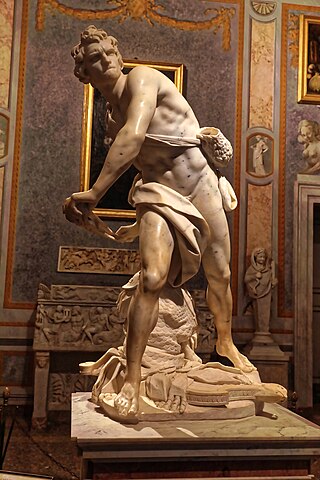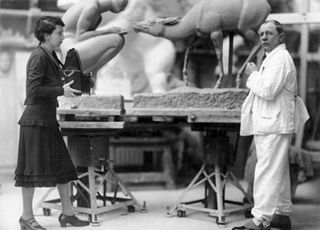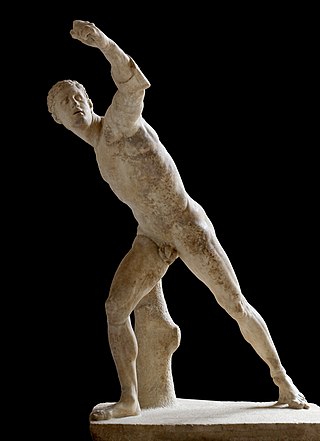
Charles Albert Fechter was an Anglo-French actor.

Charlottenburg-Wilmersdorf is the fourth borough of Berlin, formed in an administrative reform with effect from 1 January 2001, by merging the former boroughs of Charlottenburg and Wilmersdorf.

Charlottenburg is a locality of Berlin within the borough of Charlottenburg-Wilmersdorf. Established as a town in 1705 and named after Sophia Charlotte of Hanover, Queen consort of Prussia, it is best known for Charlottenburg Palace, the largest surviving royal palace in Berlin, and the adjacent museums.

The Galleria Borghese is an art gallery in Rome, Italy, housed in the former Villa Borghese Pinciana. At the outset, the gallery building was integrated with its gardens, but nowadays the Villa Borghese gardens are considered a separate tourist attraction. The Galleria Borghese houses a substantial part of the Borghese Collection of paintings, sculpture and antiquities, begun by Cardinal Scipione Borghese, the nephew of Pope Paul V. The building was constructed by the architect Flaminio Ponzio, developing sketches by Scipione Borghese himself, who used it as a villa suburbana, a country villa at the edge of Rome.

Peter Fechter was a German bricklayer who became the twenty-seventh known person to die at the Berlin Wall. Fechter was 18 years old when he was shot and killed by East German border guards while trying to cross over to West Berlin.
The Decima Flottiglia MAS was an Italian flotilla, with marines and commando frogman unit, of the Regia Marina. The acronym MAS also refers to various light torpedo boats used by the Regia Marina during World War I and World War II.

David is a life-size marble sculpture by Gian Lorenzo Bernini. The sculpture was one of many commissions to decorate the villa of Bernini's patron Cardinal Scipione Borghese – where it still resides today, as part of the Galleria Borghese. It was completed in the course of eight months from 1623 to 1624.

SC Charlottenburg is a German sports club based in the Charlottenburg district of Berlin and founded in 1902 as Charlottenburger Sport-Club 1902. In 1911, they merged with Sport-Club Westen 05 and changed their club colors from yellow and blue to black and white.

Professor Hugo Lederer was an Austro-Hungarian-born German sculptor.

The Borghese Gladiator is a Hellenistic life-size marble sculpture portraying a swordsman, created at Ephesus about 100 BC, now on display at the Louvre.

The Borghese Collection is a collection of Roman sculptures, old masters and modern art collected by the Roman Borghese family, especially Cardinal Scipione Borghese, from the 17th century on. It includes major collections of Caravaggio, Raphael, and Titian, and of ancient Roman art. Cardinal Scipione Borghese also bought widely from leading painters and sculptors of his time, and Scipione Borghese's commissions include two portrait busts by Gian Lorenzo Bernini. Most of the collection remains intact and on display at the Galleria Borghese, although a significant sale of classical sculpture was made under duress to the Louvre in 1807.

Bernardino Genga (1620–1690) was a scholar of Classical medical texts, editing several works of Hippocrates. He also had a great interest in the preparation of anatomical specimens as well as the anatomy of ancient Greek and Roman sculpture. These interests led to his work at the French Academy in Rome, where he taught anatomy to artists.

The Gladiator Mosaic is a famous set of 5 large mosaics of gladiators and venators and two smaller ones. The mosaics are dated to the first half of the 4th century and are now installed in the Salone of the Galleria Borghese in Rome. They were discovered in 1834 on the Borghese estate at Torrenova, on the Via Casilina outside Rome. Prince Francesco Borghese Aldobrandini requested the excavations be completed. It is believed to have decorated a cryptoporticus of an inner peristylum for a large domus. The mosaics were removed from excavations and restored by Gaetano Ruspi and Filippo Scaccia in 1839. These panels reinvigorated the Borghese Collection after it had shrunk following the sale of much of the collection to Napoleon I.

Three Persons Viewing the Gladiator by Candlelight is a 1765 painting by Joseph Wright of Derby and now resides in the Walker Art Gallery in Liverpool [United Kingdom]. It depicts three men examining a reproduction of the Borghese Gladiator, a famous Hellenistic statue discovered in Italy. The painting was one of the first in Wright of Derby's "Candlelight Pictures" series and was originally exhibited in London, gaining much attention. Four years later a mezzotint of it was made by William Pether.

Berlin is a city-state and the capital of the Federal Republic of Germany.

The Rebel Gladiators is a 1962 Italian peplum film directed by Domenico Paolella starring Dan Vadis, Josè Greci and Alan Steel.

The equestrian statue of Frederick William, Elector of Brandenburg is a bronze equestrian statue installed outside Charlottenburg Palace in Berlin, Germany. It was designed by Andreas Schluter.

The statue of Frederick the Great is installed outside Charlottenburg Palace in Berlin, Germany.
Astrid Timmermann-Fechter is a German politician for the CDU and since 2021 a member of the Bundestag, the federal diet.

















